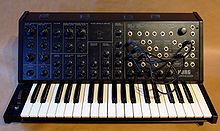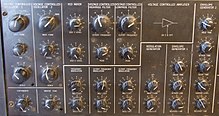Korg MS-20
| MS-20 | |
|---|---|
 Korg MS-20 | |
| Manufacturer | Korg |
| Dates | 1978–1983 Mini: 2013-present Kit: 2015 |
| Price | US$750 Mini: $600 Kit: $1399 |
| Technical specifications | |
| Polyphony | Monophonic |
| Timbrality | Monotimbral |
| Oscillator | 2 VCOs per voice |
| LFO | 1 |
| Synthesis type | Analog subtractive |
| Filter | 2 high-pass/low-pass |
| Attenuator | 2 VCA 2 envelopes |
| Aftertouch expression | no |
| Velocity expression | no |
Storage memory | none |
| Effects | none |
| Input/output | |
| Keyboard | 37 keys |
| External control | CV/Gate (all versions) MIDI (Mini and Kit) |
The Korg MS-20 is a patchable semi-modular monophonic analog synthesizer which Korg released in 1978 and which was in production until 1983.[1] It was part of Korg's MS series of instruments, which also included the single oscillator MS-10, the keyboardless MS-50 module, the SQ-10 sequencer, and the VC-10 Vocoder. Additional devices included the MS-01 Foot Controller, MS-02 Interface, MS-03 Signal Processor, and MS-04 Modulation Pedal.
Although the MS-20 follows a conventional subtractive synthesis architecture of oscillators/filter/vca, its patch panel allows some rerouting of both audio and modulation, and it includes an external signal processor. This flexibility led to its resurgence during the analog revival of the late 1990s.
In 2013, Korg responded to a revived interest in monophonic analog synthesizers by reintroducing the MS-20 in a reduced-sized form, as the MS-20 Mini. Apart from being 86% of the size of the original, the use of 1/8" jacks on the patch area, and the addition of MIDI capabilities, the MS-20 Mini is otherwise electronically identical to the original.
Contents
1 Architecture
1.1 Audio path
1.1.1 Oscillators
1.1.2 Filters
1.1.3 Output
1.2 Modulation
1.2.1 Modulation generator
1.2.2 Envelopes
1.2.3 Other sources and options
1.3 External signal processor
2 MS-20 reissues
3 Software emulations
4 Notable users
5 References
6 Further reading
7 External links
Architecture
Audio path
Oscillators

MS-20 knob section
The MS-20 has two VCOs. The output of VCO1 can be set to triangle, sawtooth, adjustable-width pulse or white noise. The output of VCO2 can be set to sawtooth, square, rectangle or "ring mod" which is in fact an exclusive-OR between the pulse output of VCO1 and the square wave output of VCO2.[citation needed] Although the pulse width of VCO1 is adjustable, there is no voltage control for this parameter and as a result pulse width modulation is not possible although mods have successfully achieved this.[citation needed] The VCOs have Hz/V voltage control inputs but note that oct/V scaling is available via judicious use of the "total" CV input socket.[citation needed]
Filters
There are two VCFs in series. The first is a 6 dB/oct [2][3] high-pass, the second a 12 dB/oct low-pass. Resonance ("peak" in Korg parlance) is adjustable but not voltage-controlled.
Originally, the filters used Korg's proprietary KORG-35 thick film IC. Later, the filters were redesigned to use off-the-shelf LM13600 OTAs. MS-20 units fitted with LM13600 filters have a small daughter board; the front panel on such units often has a tell-tale mounting screw whose head is visible in the vicinity of the VCA block diagram. However, a report to the Analogue Heaven email list in January 2010 identified an MS-20 with the front panel screw but containing the Korg 35 filter thick film circuit rather than the expected LM13600 circuit.
A useful illustration of the Korg-35 filter in-circuit is shown here [4] and some photographs illustrating the later LM13600 filter daughterboard are shown here [5] (both URLs valid as of May 4, 2013). The tonal difference between the two is that the original Korg-35 filter has a slight amount of hiss which overdrives into the sound at high resonant settings. This causes the filter to have more of a "screaming" effect similar to it being used with a distortion pedal. The revised filter has most of this noise cleared up and is less aggressive sounding.
Output
The final component in the audio path is a VCA. It is a single-transistor design, based on a selected 2SC945 which is an NPN silicon device (equivalenced by 2N2222A according to the Towers' International Transistor Selector book, update 5 (.mw-parser-output cite.citation{font-style:inherit}.mw-parser-output .citation q{quotes:"""""""'""'"}.mw-parser-output .citation .cs1-lock-free a{background:url("//upload.wikimedia.org/wikipedia/commons/thumb/6/65/Lock-green.svg/9px-Lock-green.svg.png")no-repeat;background-position:right .1em center}.mw-parser-output .citation .cs1-lock-limited a,.mw-parser-output .citation .cs1-lock-registration a{background:url("//upload.wikimedia.org/wikipedia/commons/thumb/d/d6/Lock-gray-alt-2.svg/9px-Lock-gray-alt-2.svg.png")no-repeat;background-position:right .1em center}.mw-parser-output .citation .cs1-lock-subscription a{background:url("//upload.wikimedia.org/wikipedia/commons/thumb/a/aa/Lock-red-alt-2.svg/9px-Lock-red-alt-2.svg.png")no-repeat;background-position:right .1em center}.mw-parser-output .cs1-subscription,.mw-parser-output .cs1-registration{color:#555}.mw-parser-output .cs1-subscription span,.mw-parser-output .cs1-registration span{border-bottom:1px dotted;cursor:help}.mw-parser-output .cs1-ws-icon a{background:url("//upload.wikimedia.org/wikipedia/commons/thumb/4/4c/Wikisource-logo.svg/12px-Wikisource-logo.svg.png")no-repeat;background-position:right .1em center}.mw-parser-output code.cs1-code{color:inherit;background:inherit;border:inherit;padding:inherit}.mw-parser-output .cs1-hidden-error{display:none;font-size:100%}.mw-parser-output .cs1-visible-error{font-size:100%}.mw-parser-output .cs1-maint{display:none;color:#33aa33;margin-left:0.3em}.mw-parser-output .cs1-subscription,.mw-parser-output .cs1-registration,.mw-parser-output .cs1-format{font-size:95%}.mw-parser-output .cs1-kern-left,.mw-parser-output .cs1-kern-wl-left{padding-left:0.2em}.mw-parser-output .cs1-kern-right,.mw-parser-output .cs1-kern-wl-right{padding-right:0.2em}ISBN 978-0-572-02121-4, 90100)).
Modulation

MS-20 patch field
Modulation generator
The MS-20 has a low frequency oscillator, labelled "modulation generator". It has two controls (rate and shape) and two outputs (pulse and sloped).
The shape control was a rather unusual feature for the time. It affects the duty cycle of the pulse output and the shape of the sloped output. When the control is at the anticlockwise end, the pulse width is very high (pulse output stays high for most of the cycle) and the sloped output is an upward sawtooth wave. At the clockwise end, the pulse width is very low (pulse output stays low for most of the cycle) and the sloped output is a downward sawtooth wave. At midway, the pulse width is 50% (pulse output is a square wave) and the sloped output is a triangle wave.
The pulse output is available through the patch panel. It is unipolar (0 or +5V) and suitable for triggering the S&H or the envelope generators.
The sloped output is bipolar (-2.5V to +2.5V). Like the pulse output, it is available through a dedicated jack on the patch panel. It also feeds the top modulation bus and so can be used to modulate the frequency of the VCOs and the cutoff frequency of either or both VCF without patching.
Envelopes
There are two envelope generators. EG1 has Delay, Attack, and Release parameters, whilst EG2 has Hold, Attack, Decay, Sustain and Release. The envelope generators have S-trig trigger inputs.
Other sources and options
The MS-20 also includes a noise source (pink and white), a separate vactrol-based modulation VCA, a wheel controller, and a trigger button. It is possible to connect the MS-20 to a step sequencer like the SQ-10 (another product by Korg). This involves making use of the CV input and the trigger input which connects straight to the SQ-10, this means that the synthesizer and the step sequencer can work in synchronisation to play the notes when the next step of the sequencers pattern is triggered. In theory it is possible to connect any analogue sequencer to the MS-20 providing it has a trigger and CV output.
External signal processor
The MS-20 includes a frequency-voltage converter, envelope follower and gate extractor which can be used to drive it with an external signal. By connecting the output of the F-V converter to the CV input of the VCOs (VCO 1+2 CV IN) and the output of the gate extractor to the trigger input of the envelope generators (TRIG IN), the operator can play the MS-20 through his/her voice or another instrument.
Instead of triggering the envelope generators, one can connect the output of the envelope follower to the main VCA's INITIAL GAIN input. In that mode of operation, the envelope generators are not used and the envelope of the MS-20's output is simply that of the external signal.
MS-20 reissues

The fully built MS-20 Kit – the limited edition kit version of the MS-20 Mini.
In January, 2013, Korg announced at NAMM that the company would release the Korg MS-20 mini. It is 86% the size of the Korg MS-20. The mini was designed by the engineers who developed the original MS-20. It aims to be a faithful re-release of the original electronic circuits of the MS-20. The MS-20 mini features 1/8-inch input and output jacks, a MIDI IN jack as well as USB MIDI (input and output).[6]
In January, 2014, Korg announced that they would release a limited edition full-size unassembled MS-20. Like the MS-20 Mini, the module kit adds MIDI and USB connectivity. The MS-20 Kit also includes both MS-20 filter revisions, selectable by the user.
In January, 2015, Korg announced at the 2015 NAMM show they would release an unassembled desktop kit called the "MS-20M Kit." This kit does not include a keyboard and is being sold as a bundle with the Korg SQ-1 step sequencer. This version features self-oscillating high-pass/low-pass filters with distinctive distortion, toggle switches for VCO 1 to 2 sync / VCO 1 to 2 FM, a toggle to switch between rev 1 and rev 2 filter designs, PWM IN jack allows pulse width modulation, supports all CV/GATE specifications: Hz/V and V/Oct, S-Trig and V-Trig, a MIDI IN connector and USB MIDI connector, and adds a junction patching bay for integration with SQ-1.
Software emulations
There is a software emulator of the MS-20 included in the KORG legacy Collection. As well as a standalone emulator, the Legacy Collection provides the MS-20 as a virtual instrument (VST). The external signal processor is implemented separately as a VST effect called MS-20EX. This same software emulated MS-20 was also part of the LAC-1 expansion for the Korg OASYS and is one of the Korg Kronos sound engines.
KORG DS-10 is a music creation program for the Nintendo DS that emulates the Korg MS range of synthesizers.
KORG iMS-20 is an MS-20 emulator for the iPad.
Notable users
- Add N to (X)
- Air
- Alec Empire
- Alphaville
- Aphex Twin
- Apoptygma Berzerk
- Arcade Fire
- Asian Dub Foundation
- Astral Projection
- Atoms for Peace
- Autechre
Ákos Nagy [1]
- BBC Radiophonic Workshop
- Beborn Beton
- Broadcast (band)
- Chicks on Speed
Chrislo Haas[7]
- Cluster ensemble
- Coil
- Ian J. Cook (musician and sound designer)
- Covenant
- Daddy DJ
- Daft Punk
- The Dandy Warhols
- David Scott Stone
- Depeche Mode
- Der Plan
- Deutsch Amerikanische Freundschaft
- Die Krupps
- Digitalism
Steve Hillier of Dubstar
- Einstürzende Neubauten
- Electrosexual
- Eliot Lipp
- Erasure
- Ernest Blackwell
- Felix Kubin
- Fad Gadget
- The Faint
- The Fall
- A Flock of Seagulls
- Foals
- Fortran 5
- Friendly Fires
- Eloy Fritsch
- Front 242
- Front Line Assembly
- Futurians
- Gaudi
- Greg Anderson
- Goldfrapp
- Gorillaz
- Susumu Hirasawa
- Ian Cook
- Indochine
- Information Society
- Jon Hopkins
- Juno Reactor
- Justice
- Kas Product
- Kevin Schmidt
- Kid606
- KMFDM
- Klaxons
Kurt Dahlke[7]
- Ladytron
- Laibach
- Legowelt
- Liaisons Dangereuses
- Luigi Tozzi
Mike Parker[disambiguation needed]
- Mr. Oizo
- MSTRKRFT
- Neon Indian
- Orchestral Manoeuvres in the Dark
- The Presets
- The Prodigy
- Portishead
- Röyksopp
- Safety Scissors
- Scooter
- Severed Heads
- Shapeshifter
- Simeone
- Simian Mobile Disco
- Simon Posford
- Skinny Puppy
- Skyphone
- Snap!
- Snarky Puppy
- Soulwax
- Spleen United
- Stephen O'Malley
Robert Görl[7]
- Rodrigo Etchebarne
- Trentemøller
- Ufomammut
- Villa Rosa
- Vince Clarke
- William Orbit
- Wumpscut
- Yann Tiersen
- Yuksek
- Zen Paradox
References
^ http://www.cyborgstudio.com/synthmp3s/korg/ms20/manual/ms20servicemanual.pdf
^ http://www.timstinchcombe.co.uk/synth/MS20_study.pdf
^ "A-106". Doepfer.de. 2010-06-18. Retrieved 2013-10-07.
^ https://web.archive.org/web/20150619232549/http://www.punkdisco.co.uk/misc/gear/Korg/MS20/Disassemble1.jpg
^ "KORG MS-20 "VERSION 2"". Nwheaton.homemail.com.au. 2006-05-11. Retrieved 2013-10-07.
^ "RA Reviews: Korg - MS-20 Mini (Tech)". Residentadvisor.net. Retrieved 2013-10-07.
^ abc Rudi Esch, Electri_City: The Düsseldorf School of Electronic Music, page 257, Omnibus Press
Further reading
"Retro: Korg MS-20". Future Music. No. 43. Future Publishing. May 1996. p. 50. ISSN 0967-0378. OCLC 1032779031.
External links
- Korg Kornucopia - Korg analogue synthesizer information, manuals and resources
- More Korg info
- Vintage Synth Explorer Korg MS-20 page
- Korg MS-20 instruction videos